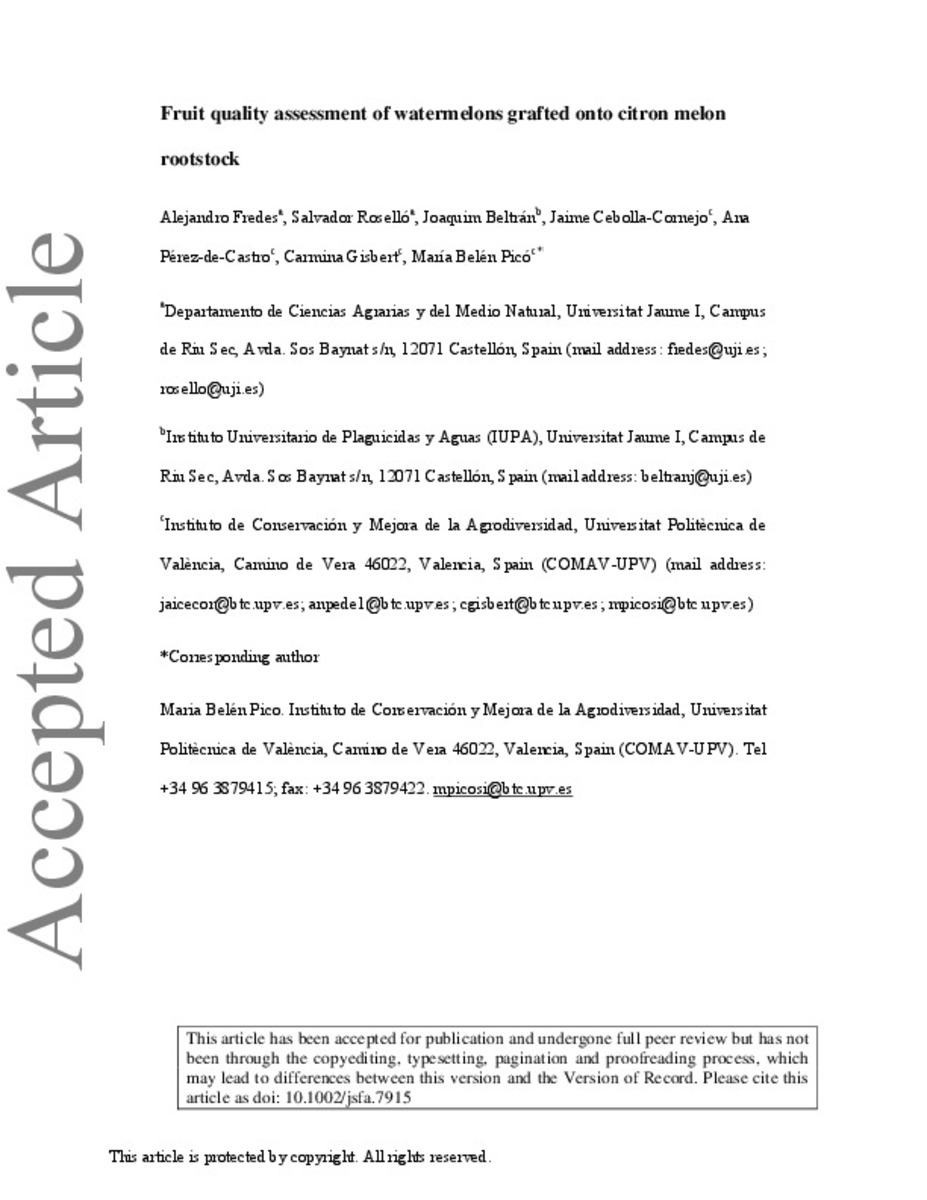Mostrar el registro sencillo del ítem
Fruit quality assessment of watermelons grafted onto citron melon rootstock
| dc.contributor.author | Fredes Sivoplás, Alejandro David | |
| dc.contributor.author | Roselló, Salvador | |
| dc.contributor.author | Beltran Arandes, Joaquin | |
| dc.contributor.author | Cebolla-Cornejo, Jaime | |
| dc.contributor.author | Pérez de Castro, Ana | |
| dc.contributor.author | Gisbert, Patricia | |
| dc.contributor.author | Picó, María Belén | |
| dc.date.accessioned | 2016-11-09T08:59:45Z | |
| dc.date.available | 2016-11-09T08:59:45Z | |
| dc.date.issued | 2016-07-20 | |
| dc.identifier.citation | FREDES SIVOPLÁS, Alejandro David; ROSELLÓ RIPOLLÉS, Salvador; BELTRÁN ARANDES, Joaquim; CEBOLLA CORNEJO, Jaime; PÉREZ DE CASTRO, Ana; GISBERT, Carmina; PICÓ, María Belén. Fruit quality assessment of watermelons grafted onto citron melon rootstock. Journal of the Science of Food and Agriculture (2016), online, pp. 1-10 | ca_CA |
| dc.identifier.issn | 0022-5142 | |
| dc.identifier.uri | http://hdl.handle.net/10234/164282 | |
| dc.description.abstract | BACKGROUND: The grafting of watermelons (Citrullus lanatus) is a common technique that increases yield under stressful soil conditions. The most common rootstocks for watermelons are Cucurbita hybrids. However, they often have a negative impact on fruit quality. Exploiting novel Citrullus germplasm such as citron melon (Citrullus lanatus var. citroides) is an alternative to avoid these quality problems. RESULTS: Citron melon has been validated as watermelon rootstock, comparing its effects on watermelon quality to those of Cucurbita hybrids. Larger fruits with thicker rinds were observed in fruits from plants grafted onto both citron and Cucurbita rootstocks. The citron melon had no significant effect on flesh sugars or acid profiles compared to non-grafted watermelons, except for an increase in glucose and malic acid content, which also occurred in the Cucurbita rootstocks. The aroma profile of fruits produced on citron melon was similar to that of the non-grafted and self-grafted controls. The citron rootstock did not display the increased levels of (Z)-6-nonen-1-ol (a compound associated with pumpkin-like odors) found in fruits produced with Cucurbita hybrids. CONCLUSION: The low impact of citron melon rootstock on fruit quality, along with the enhanced resistance against nematodes, make the citron a promising alternative to Cucurbita rootstocks. | ca_CA |
| dc.description.sponsorShip | This study was partially supported by the projec t funded by the Ministerio de Economía y Competitividad AGL2014-53398-C2-2-R (jointly funded by FEDER). | ca_CA |
| dc.format.extent | 33 p. | ca_CA |
| dc.format.mimetype | application/pdf | ca_CA |
| dc.language.iso | eng | ca_CA |
| dc.publisher | Society of Chemical Industry | ca_CA |
| dc.relation.isPartOf | Journal of the Science of Food and Agriculture (2016), online, | ca_CA |
| dc.rights.uri | http://rightsstatements.org/vocab/CNE/1.0/ | * |
| dc.subject | Citrullus lanatus | ca_CA |
| dc.subject | Fruit quality | ca_CA |
| dc.subject | Grafting | ca_CA |
| dc.subject | Aroma profile | ca_CA |
| dc.title | Fruit quality assessment of watermelons grafted onto citron melon rootstock | ca_CA |
| dc.type | info:eu-repo/semantics/article | ca_CA |
| dc.identifier.doi | http://dx.doi.org/10.1002/jsfa.7915 | |
| dc.rights.accessRights | info:eu-repo/semantics/openAccess | ca_CA |
| dc.relation.publisherVersion | http://onlinelibrary.wiley.com/doi/10.1002/jsfa.7915/epdf | ca_CA |
| dc.edition | Postprint | ca_CA |
Ficheros en el ítem
Este ítem aparece en la(s) siguiente(s) colección(ones)
-
CAMN_Articles [566]







